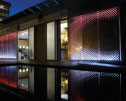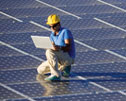As public concern escalates regarding climate change, massive oil spills and other unwelcome environmental events, the desire for clean, reliable and renewable energy continues to grow. And for an increasing number of homeowners and business owners, the idea of harvesting sunlight to meet their energy needs is more attractive than ever.
Homes' and businesses' use of solar panels clearly is increasing. The Energy Information Administration (EIA), a division of the Department of Energy, reports shipments of photovoltaic (PV) units rose from 21,000 units during 1999 to more than 520,000 cells and modules during 2008.
And EIA foresees a bright future for this endlessly renewable energy source. According to its website: "Solar radiation, which is nearly constant outside the Earth's atmosphere, varies with changing atmospheric conditions. Nevertheless, almost all U.S. regions have useful solar resources that can be accessed."
As more homeowners and business owners contemplate installing PV systems on their roofs or other parts of their buildings, it is important to address safety issues associated with managing solar power on-site.
Two of the biggest concerns associated with installing and operating PV modules are the potential for electrical shock and fire. Fire safety takes on great urgency in communities where many homes and small commercial buildings are partially or completely constructed of wood.
In addition to traditional roof-mounted PV modules, the solar industry has begun incorporating PV technology into other roofing materials, such as shingles and roof tiles. The result is PV systems that provide the same energy-generating benefits while also integrating into the architectural aesthetics of existing structures. These innovative developments, though important in promoting more expansive use of solar energy, may present additional safety concerns.
Therefore, PV modules are subjected to testing according to the applicable safety standards before they are placed on roofs or other parts of buildings, and PV system installers should be trained and certified to install the systems properly and safely.
PV testing
Underwriters Laboratories (UL) Inc., Northbrook, Ill., has been involved with safety testing PV products since the 1980s when it first developed a safety standard for PV modules—UL 1703, "Standard for Safety of Flat-Plate Photovoltaic Modules and Panels." With the recent rapid adoption of solar power in the U.S., UL is now developing new and expanded PV module testing capabilities.
In 2008, UL opened its largest solar testing and certification facility in San Jose, Calif., and expanded the facility in 2009 because of demand. There, PV modules are subjected to a battery of electrical safety, performance and endurance tests designed to simulate extremes of heat, cold and precipitation.
At UL's headquarters, fire safety experts run flame tests to determine whether roof-mounted PV modules have similar fire-resistance properties as those required of traditional roof systems.
One objective of safety testing is to identify any potential safety hazards as outlined in the relevant standards that manufacturers must address before bringing their solar products to market. The U.S. national electrical code now requires all PV modules sold in the U.S. to meet UL certification standards.
To better serve PV manufacturers throughout the world, UL continues to grow its global network of testing and certification systems. In 2008, UL opened a new PV Center of Excellence in Suzhou, China, as well as one in Frankfurt, Germany, in early 2010. Facilities in Ise, Japan, and Bangalore, India, are slated to open later this year.
UL's PV testing facilities test product samples for fire resistance, weather damage, reliability and other specific parameters. The services available at UL's PV testing facilities allow for global conformity assessment according to UL, the International Electrotechnical Commission (IEC) and European standards certification requirements, including testing against UL 1703; UL 61730, which is based on IEC 61730, "Photovoltaic (PV) module safety qualification," and currently being developed; IEC 61215, "Crystalline Silicon Terrestrial Photovoltaic (PV) Modules—Design Qualification and Type Approval"; IEC 61646, "Thin-film terrestrial photovoltaic (PV) modules—Design qualification and type approval"; and IEC 61730. Testing also is available for other related purposes to serve manufacturers through their product development processes, as well as for PV system installers and designers.
Installer certification
To help improve the safety and performance of PV systems through a more professionally qualified work force, UL University offers a training and certification program for licensed electricians who will be tasked with the installation of residential and/or commercial PV systems. The new training program is a cooperation of industry stakeholders, organizations and professional associations, including the International Brotherhood of Electrical Workers, International Association of Electrical Inspectors and National Electrical Contractors Association.
UL University's PV system installer course strives to mitigate unsafe PV installations, which can cause fire, shock and mechanical hazards and may significantly reduce installed products' lifespans. During the five-day course, students gain hands-on skills in constructing a PV array, installing wiring and equipment, and conducting tests and studying safety regulations in the field. Multiple types of roof-mounted PV installations are addressed, and students spend a majority of their training installing live systems, including system hardware.
By the end of 2010, UL University expects to certify 100 people. And during its first full year, UL University expects to train more than 1,000 electricians and other industry personnel.
An ongoing challenge
The biggest challenge the U.S. solar market faces to achieve wider acceptance is the need to reduce the price of PV systems, a hurdle likely to be cleared through the increased scale of production and distribution of solar energy technology.
State and federal incentive programs combined with greatly reduced energy bills and the public's environmental conscience likely will encourage more homeowners and businesses to convert to solar energy in the years ahead. As the solar market continues to expand, competition and product innovation should reduce PV technology costs.
As the global PV industry grows and embraces new technologies, safety and certification standards likewise must keep pace. UL plans to continue to play a role in establishing such standards and helping manufacturers meet those standards quickly and effectively.
Jeffrey Smidt is vice president and general manager of the Global Energy Business at Underwriters Laboratories Inc., Northbrook, Ill.



